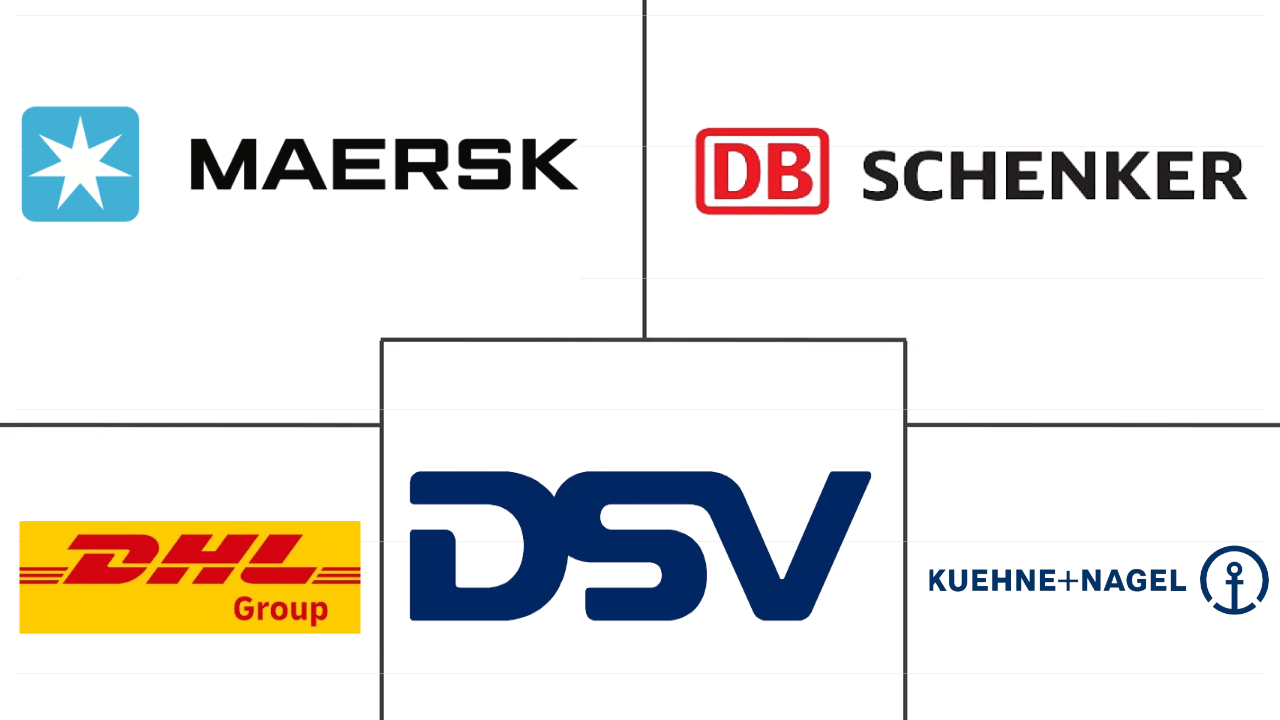Market Size of europe freight and logistics Industry
|
|
Study Period | 2017 - 2030 |
|
|
Market Size (2024) | USD 1.27 Trillion |
|
|
Market Size (2030) | USD 1.55 Trillion |
|
|
Largest Share by Logistics Function | Freight Transport |
|
|
CAGR (2024 - 2030) | 3.37 % |
|
|
Largest Share by Country | Germany |
Major Players |
||

|
||
|
*Disclaimer: Major Players sorted in no particular order |
Europe Freight And Logistics Market Analysis
The Europe Freight And Logistics Market size is estimated at 1.27 trillion USD in 2024, and is expected to reach 1.55 trillion USD by 2030, growing at a CAGR of 3.37% during the forecast period (2024-2030).
1.27 Trillion
Market Size in 2024 (USD)
1.55 Trillion
Market Size in 2030 (USD)
2.45 %
CAGR (2017-2023)
3.37 %
CAGR (2024-2030)
Fastest Growing Market by Mode of Transport
3.77 %
Projected CAGR, Sea and Inland Waterways, 2024-2030
As part of a new national port strategy, France aims to raise the share of containerized freight handled by its seaports from 60% in 2022 to 80% by 2050.
Largest CEP Market by Destination
65.52 %
value share, Domestic, 2023
Amazon.co.uk, tesco.com, and argos.co.uk account for 30% of the online sales revenue generated in the UK. These online retailers have a significant impact on domestic CEP volumes.
Largest Country
16.81 %
value share, Germany, 2023

To facilitate a smooth supply chain, the German government announced a USD 626 million package of financial support for the 15 most important airports in the country.
Largest Market by End User Industry
35.72 %
value share, Wholesale and Retail Trade, 2023
In 2023, the end-user segment experienced growth supported by the rise in e-commerce. The e-commerce sector in Germany grew by 7.8% YoY in 2023. Similarly, the French e-commerce sector grew by 7% YoY.
Fastest Growing Warehousing Market by Temperature Control
3.22 %
Projected CAGR, Temperature Controlled, 2024-2030
Free trade agreements between EU nations boosted trade, leading to increased cold storage throughout Europe. The cold chain market in Europe is predicted to grow to USD 112 billion by 2028.
Rising investments, including USD 15 billion, from the German government are developing the market
- The United Kingdom aims to have zero emissions from new heavy goods vehicles by 2040. The UK electric truck market is expected to record a CAGR of 70% during 2020-2026, reaching 2,167 units in 2026. In 2022, Amazon launched 5 electric heavy goods vehicles (HGVs) in its delivery fleet, covering 100,000 annual road miles to cut down over 170 tonnes of carbon emissions. The country is working toward installing a nationwide network of overhead wires to power long-distance electric trucks as part of efforts to decarbonize the transportation sector by 2050.
- In 2020, Germany witnessed a significant investment of nearly USD 35.12 billion in its transport infrastructure, with a major chunk, 86.6%, allocated to the construction and maintenance of traffic routes. The German federal government's spending on transport infrastructure saw a notable uptick in 2022 compared to 2021. Of particular significance was the allocation of USD 12.45 billion to federal railroads in 2021, more than double the amount allocated in 2016. In 2022, the budget allocated over USD 13.58 billion for federal highways and USD 1.92 billion for waterways.
- The French government has outlined its infrastructure spending plans until 2028, with a significant focus on highways, earmarking investments worth EUR 5.1 billion (USD 5.44 billion). As part of the ambitious France 2030 investment plan, the government has committed EUR 2.5 billion (USD 2.66 billion) to bolster the production of nearly two million electric and hybrid vehicles by 2030. In 2022, the government also initiated a call for projects to facilitate the deployment of high-power charging stations for electric vehicles. These strategic moves by the French government are poised to bolster the growth of short-haul trucking in the country.
Cross-border e-commerce is driving growth and transforming freight and logistics in Europe
- The German government has allocated a financial support package of USD 626 million to bolster the supply chain operations in the country's 15 key airports. Out of this, USD 426 million is earmarked for smaller airports, specifically for air navigation services and traffic control infrastructure. With a target of achieving net-zero climate emissions by 2045, Germany recognizes the significance of decarbonizing its transportation sector, which currently accounts for about 20% of the nation's emissions. This focus on sustainability is further underscored by heightened industry awareness, with the Luftfahrt-Bundesamt (LBA) serving as Germany's national authority overseeing environmental, security, safety, and personnel matters in civil aviation.
- In 2023, UK-based rail company Colas Rail made its foray into the French market by launching a new subsidiary, Colas Rail Traction, which recently obtained its rail license. Headquartered in Louveciennes, west of Paris, the subsidiary is set to employ a workforce of 140. Colas Rail Traction's core operations will revolve around the transportation of machinery, work trains, and freight, complementing its existing subsidiary, Colas Rail France, which specializes in rail design, construction, and maintenance.
- The UK's CEP (Courier, Express, and Parcel) industry witnessed a significant surge, with the number of enterprises rising from 12,550 in 2012 to 39,165 in 2021, marking an impressive annual growth rate of 13.48%. With e-commerce projected to reach a penetration rate of 90% by 2025, CEP companies are poised to capitalize on the expanding online consumer market. Notably, clothing and gadgets are among the top products UK consumers prefer to order online.
Europe Freight And Logistics Industry Segmentation
Agriculture, Fishing, and Forestry, Construction, Manufacturing, Oil and Gas, Mining and Quarrying, Wholesale and Retail Trade, Others are covered as segments by End User Industry. Courier, Express, and Parcel (CEP), Freight Forwarding, Freight Transport, Warehousing and Storage are covered as segments by Logistics Function. Denmark, Finland, France, Germany, Iceland, Italy, Netherlands, Norway, Russia, Spain, Sweden, United Kingdom are covered as segments by Country.
- The United Kingdom aims to have zero emissions from new heavy goods vehicles by 2040. The UK electric truck market is expected to record a CAGR of 70% during 2020-2026, reaching 2,167 units in 2026. In 2022, Amazon launched 5 electric heavy goods vehicles (HGVs) in its delivery fleet, covering 100,000 annual road miles to cut down over 170 tonnes of carbon emissions. The country is working toward installing a nationwide network of overhead wires to power long-distance electric trucks as part of efforts to decarbonize the transportation sector by 2050.
- In 2020, Germany witnessed a significant investment of nearly USD 35.12 billion in its transport infrastructure, with a major chunk, 86.6%, allocated to the construction and maintenance of traffic routes. The German federal government's spending on transport infrastructure saw a notable uptick in 2022 compared to 2021. Of particular significance was the allocation of USD 12.45 billion to federal railroads in 2021, more than double the amount allocated in 2016. In 2022, the budget allocated over USD 13.58 billion for federal highways and USD 1.92 billion for waterways.
- The French government has outlined its infrastructure spending plans until 2028, with a significant focus on highways, earmarking investments worth EUR 5.1 billion (USD 5.44 billion). As part of the ambitious France 2030 investment plan, the government has committed EUR 2.5 billion (USD 2.66 billion) to bolster the production of nearly two million electric and hybrid vehicles by 2030. In 2022, the government also initiated a call for projects to facilitate the deployment of high-power charging stations for electric vehicles. These strategic moves by the French government are poised to bolster the growth of short-haul trucking in the country.
| End User Industry | |
| Agriculture, Fishing, and Forestry | |
| Construction | |
| Manufacturing | |
| Oil and Gas, Mining and Quarrying | |
| Wholesale and Retail Trade | |
| Others |
| Logistics Function | |||||||||
| |||||||||
| |||||||||
| |||||||||
| |||||||||
| Other Services |
| Country | |
| Denmark | |
| Finland | |
| France | |
| Germany | |
| Iceland | |
| Italy | |
| Netherlands | |
| Norway | |
| Russia | |
| Spain | |
| Sweden | |
| United Kingdom | |
| Rest of Europe |
Europe Freight And Logistics Market Size Summary
The Europe Freight and Logistics Market is poised for significant growth, driven by strategic investments and regulatory initiatives across the region. The market is characterized by a focus on sustainability, with countries like the United Kingdom and Germany leading efforts to decarbonize their transportation sectors. The UK is working towards zero emissions from new heavy goods vehicles by 2040, while Germany has made substantial investments in transport infrastructure, particularly in rail and road networks. France is also making strides with its France 2030 investment plan, which includes significant investments in electric and hybrid vehicle production and infrastructure. These efforts are supported by the European Union's commitment to enhancing transport links and promoting sustainable transportation through the Trans-European Transport Network.
The market landscape is fragmented, with major players such as A.P. Moller - Maersk, DB Schenker, DHL Group, DSV A/S, and Kuehne + Nagel holding a significant share. Recent developments include Dachser's expansion of its food distribution network and Kuehne + Nagel's introduction of decarbonization solutions for road freight. The UK's Courier, Express, and Parcel industry is experiencing rapid growth, fueled by the rise of e-commerce. Additionally, the market is adapting to changes in fuel supply dynamics, with a shift in diesel imports following the EU's ban on Russian petroleum products. These trends underscore the evolving nature of the Europe Freight and Logistics Market, as it navigates challenges and opportunities in the coming years.
Europe Freight And Logistics Market Size - Table of Contents
-
1. MARKET SEGMENTATION (includes 1. Market value in USD for all segments 2. Market volume for select segments viz. freight transport, CEP (courier, express, and parcel) and warehousing & storage 3.Forecasts up to 2029 and analysis of growth prospects)
-
1.1 End User Industry
-
1.1.1 Agriculture, Fishing, and Forestry
-
1.1.2 Construction
-
1.1.3 Manufacturing
-
1.1.4 Oil and Gas, Mining and Quarrying
-
1.1.5 Wholesale and Retail Trade
-
1.1.6 Others
-
-
1.2 Logistics Function
-
1.2.1 Courier, Express, and Parcel (CEP)
-
1.2.1.1 By Destination Type
-
1.2.1.1.1 Domestic
-
1.2.1.1.2 International
-
-
-
1.2.2 Freight Forwarding
-
1.2.2.1 By Mode Of Transport
-
1.2.2.1.1 Air
-
1.2.2.1.2 Sea and Inland Waterways
-
1.2.2.1.3 Others
-
-
-
1.2.3 Freight Transport
-
1.2.3.1 By Mode Of Transport
-
1.2.3.1.1 Air
-
1.2.3.1.2 Pipelines
-
1.2.3.1.3 Rail
-
1.2.3.1.4 Road
-
1.2.3.1.5 Sea and Inland Waterways
-
-
-
1.2.4 Warehousing and Storage
-
1.2.4.1 By Temperature Control
-
1.2.4.1.1 Non-Temperature Controlled
-
1.2.4.1.2 Temperature Controlled
-
-
-
1.2.5 Other Services
-
-
1.3 Country
-
1.3.1 Denmark
-
1.3.2 Finland
-
1.3.3 France
-
1.3.4 Germany
-
1.3.5 Iceland
-
1.3.6 Italy
-
1.3.7 Netherlands
-
1.3.8 Norway
-
1.3.9 Russia
-
1.3.10 Spain
-
1.3.11 Sweden
-
1.3.12 United Kingdom
-
1.3.13 Rest of Europe
-
-
Europe Freight And Logistics Market Size FAQs
How big is the Europe Freight And Logistics Market?
The Europe Freight And Logistics Market size is expected to reach USD 1273.65 billion in 2024 and grow at a CAGR of 3.37% to reach USD 1553.43 billion by 2030.
What is the current Europe Freight And Logistics Market size?
In 2024, the Europe Freight And Logistics Market size is expected to reach USD 1273.65 billion.

